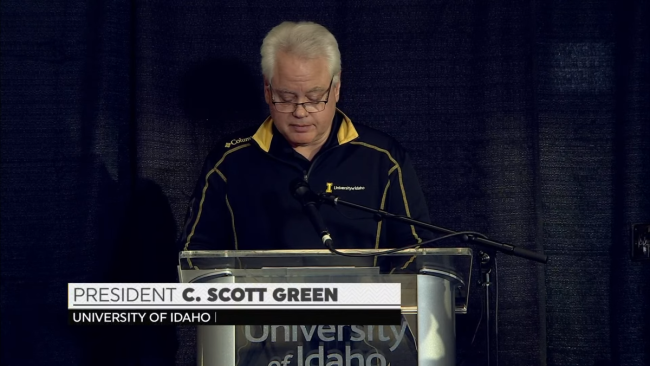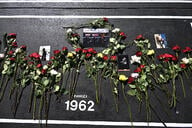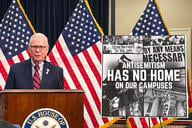You have /5 articles left.
Sign up for a free account or log in.

University of Idaho president Scott Green has stressed the need for flexibility as students navigate the aftermath of four killings near campus.
YouTube/University of Idaho
Few answers have emerged more than a week after four University of Idaho students were stabbed to death in a home less than a mile from campus. The incident has left the community frightened and local police grasping for leads.
The four victims—Ethan Chapin, 20; Kaylee Goncalves, 21; Xana Kernodle, 20; and Madison Mogen, 21—were found dead in an off-campus residence on Nov. 13. As the investigation grinds on, details are sparse and the threat level unclear; local police initially suggested the community was not in danger but has since backtracked on that statement with the killer still at large.
Many students fled campus early for Thanksgiving. As the break gets underway, the search for the killer continues, with state and federal authorities stepping in to assist local police. Yet even with the federal government involved, the investigation appears to be moving painfully slowly, leaving students and community members on edge in the aftermath of a horrific slaying.
The Investigation
For the peaceful college town of Moscow, with a population of around 25,000, the killing of four students is an anomaly. University of Idaho crime statistics reveal a campus with the same safety and behavioral concerns as other U.S. institutions but largely devoid of violent crime.
Now an unknown killer with unclear motives has cast a shadow over Moscow.
The victims lived life as many college students do. On Saturday night, Nov. 12, Chapin and Kernodle went to a fraternity party; Goncalves and Mogen visited a sport bar and then a food truck. All four victims returned home before 2:00 a.m. But at some point in the night, normalcy became tragedy. All four were stabbed to death, apparently as they slept. Their bodies were discovered the next morning.
Local authorities noted there was no sign of forced entry or sexual assault. Some of the victims showed defensive wounds. Three of the victims lived in the house; the fourth, Chapin, was dating Kernodle. Two other roommates who were home during the stabbing were unharmed. Police have said they are not suspects and appear to have slept through the attacks.
Though local authorities have described the killings as targeted, they have declined to specify why or who they believe was the target of the deadly attack, citing the ongoing investigation.
“It is a complex and terrible crime and will take some time to resolve,” Moscow police chief James Fry said in a Sunday press conference offering an update on the investigation.
More than 30 members of the Moscow Police Department are working on the case, along with 20 state police investigators—and another 15 state troopers tapped to serve the community—as well as 22 FBI investigators locally and more nationally, including two behavioral analysts. Authorities have received more than 146 tips and conducted over 90 interviews, according to local police.
The University Response
The University of Idaho has ramped up security in the aftermath of the killings, as well as provided counseling services and therapy dogs on campus.
A candlelight vigil is scheduled for Nov. 30 on campus.
In both a university statement and at Sunday’s press conference, University of Idaho president Scott Green stressed the need for flexibility for students as they process the tragedy.
“The University of Idaho’s primary focus now is on supporting our students and working to meet their needs,” Green said. “The police continue to inform us that this was a targeted attack, but we recognize that this is not good enough for some of our students, who will want to complete the rest of their semester remotely until the person who committed the crime is in custody. We are also hearing that some students want to be back and in Moscow because they gain comfort from the structure of classes and being with their friends and professors.”
Green said the university will be prepared to work with students who return to campus as well as those who continue the semester remotely. He asked professors to prepare for both options.
Kelly Quinnett, a professor in the theatre arts department and Faculty Senate chair, said that students will have a range of options as needed. She noted that faculty had been forced to pivot online during the COVID-19 pandemic, building up a suite of online instruction tools that can be leveraged now. That might mean fully online classes or hybrid ones, where some students are in person and others remote.
Quinnett said that Moscow is in the middle of farmland and nearly 100 miles from any major airports. She called it “a dear, sweet town that’s been rocked by this tragedy.”
Brian Smentkowski, a professor of political science and the founding director of the Center for Excellence in Teaching and Learning at the university, said that with students still reeling from recent events, the center has drafted documents to help faculty members teach in times of crisis.
“There is no single solution. Our faculty are rather extraordinary. Many have proactively reached out to their students to express their concern and commitment to them. Many have adapted best practices for using technology to bring educational opportunities to our students, no matter where they are. Many chairpersons have reminded us to think about every student as we teach out the rest of the semester. And they are leading with care, compassion, understanding and empathy. Right now, that’s what matters. And this ties directly into the decisions we make about teaching and learning. And this directly effects, in a very positive way, our pedagogical priorities,” Smentkowski said by email.
A Deadly Fall
On the same weekend that violence claimed four lives at the University of Idaho, three football players at the University of Virginia were also shot and killed. The alleged perpetrator—Christopher Darnell Jones Jr., a UVA student and former member of the football team—was quickly apprehended and charged with three felony counts of second-degree murder.
The incidents at UVA and Idaho came a little more than a month after a deadly shooting at the University of Arizona, where a professor was killed, allegedly by a former graduate student.
Just this past weekend, a University of New Mexico student was shot and killed on campus by New Mexico State University basketball player Mike Peake. According to details from The Albuquerque Journal, that killing was in self-defense, as the victim and others had lured Peake to campus. Peake was shot, then returned fire, killing the alleged attacker, the newspaper reported.
The shooting came on the cusp of the New Mexico and New Mexico State men’s basketball game. The contest between the two rival colleges was postponed following the shooting.
Now, as justice plays out elsewhere, the University of Idaho awaits peace and closure amid a holiday tragedy.




